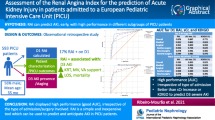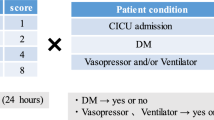Abstract
The context of a diagnostic test is a critical component for the interpretation of its result. This context defines the pretest probability of the diagnosis and forms the basis for the interpretation and value of adding the diagnostic test. In the field of acute kidney injury, a multitude of early diagnostic biomarkers have been developed, but utilization in the appropriate context is less well understood and has not been codified until recently. In order to better operationalize the context and pretest probability assessment for acute kidney injury diagnosis, the renal angina concept was proposed in 2010 for use in both children and adults. Renal angina has been assessed in approximately 1,000 subjects. However, renal angina as a concept is still unfamiliar to most clinicians and the rationale for introducing the term is not obvious. We therefore review the concept and development of renal angina, and the currently available data validating it. We discuss the various arguments for and against this construct. Future research testing the performance of renal angina with acute kidney injury biomarkers is warranted.


Similar content being viewed by others
Abbreviations
- ACS:
-
Acute coronary syndrome
- AKI:
-
Acute kidney injury
- AUC:
-
Area under the curve
- HT:
-
Hazard tranche
- NPV:
-
Negative predictive value
- RA:
-
Renal angina
- RAI:
-
Renal angina index
- ROC:
-
Receiver operating characteristic
References
Ebell MH, White LL, Weismantel D. A systematic review of troponin T and I values as a prognostic tool for patients with chest pain. J Fam Pract. 2000;49:746–53.
Stein R, Gupta B, Agarwal S, Golub J, Bhutani D, Rosman A, et al. Prognostic implications of normal (<0.10 ng/ml) and borderline (0.10 to 1.49 ng/ml) troponin elevation levels in critically ill patients without acute coronary syndrome. Am J Cardiol. 2008;102:509–12.
Lim W, Whitlock R, Khera V, Devereaux PJ, Tkaczyk A, Heels-Ansdell D, et al. Etiology of troponin elevation in critically ill patients. J Crit Care. 2010;25:322–8.
Hammerer-Lercher A, Ploner T, Neururer S, Schratzberger P, Griesmacher A, Pachinger O, et al. High-sensitivity cardiac troponin T compared with standard troponin T testing on emergency department admission: how much does it add in everyday clinical practice? J Am Heart Assoc. 2013;2:e000204.
KDIGO clinical practice guideline for acute kidney injury. Kidney Int. 2012, 2:1–141.
Bellomo R, Kellum JA, Ronco C. Acute kidney injury. Lancet. 2012;380:756–66.
Siew ED, Ware LB, Ikizler TA. Biological markers of acute kidney injury. J Am Soc Nephrol. 2011;22:810–20.
Bonventre JV. Diagnosis of acute kidney injury: from classic parameters to new biomarkers. Contrib Nephrol. 2007;156:213–9.
Devarajan P. Emerging biomarkers of acute kidney injury. Contrib Nephrol. 2007;156:203–12.
Parikh NI, Vasan RS. Assessing the clinical utility of biomarkers in medicine. Biomark Med. 2007;1:419–36.
Kashani K, Al-Khafaji A, Ardiles T, Artigas A, Bagshaw SM, Bell M, et al. Discovery and validation of cell cycle arrest biomarkers in human acute kidney injury. Crit Care. 2013;17:R25.
Goldstein SL, Chawla LS. Renal angina. Clin J Am Soc Nephrol. 2010;5:943–9.
Basu RK, Zappitelli M, Brunner L, Wang Y, Wong HR, Chawla LS, et al. Derivation and validation of the renal angina index to improve the prediction of acute kidney injury in critically ill children. Kidney Int. 2014;85:659–67.
Cruz DN, Ferrer-Nadal A, Piccinni P, Goldstein SL, Chawla LS, Alessandri E, et al. Utilization of small changes in serum creatinine with clinical risk factors to assess the risk of AKI in critically ill adults. Clin J Am Soc Nephrol. 2014;9:663–72.
Faubel S, Chawla LS, Chertow GM, Goldstein SL, Jaber BL, Liu KD, et al. Ongoing clinical trials in AKI. Clin J Am Soc Nephrol. 2012;7:861–73.
Barkin RM, Bonis SL, Elghammer RM, Todd JK. Ludwig angina in children. J Pediatr. 1975;87:563–5.
Quinn Jr FB. Ludwig angina. Arch Otolaryngol Head Neck Surg. 1999;125:599.
Hsu CL, Chen CW. A prolonged buried fish bone mimicking Ludwig angina. Am J Otolaryngol. 2011;32:75–6.
Carlson DS, Pfadt E. Vincent and Ludwig angina: two damaging oral infections. Nursing. 2011;41:55–8.
Marcus BJ, Kaplan J, Collins KA. A case of Ludwig angina: a case report and review of the literature. Am J Forensic Med Pathol. 2008;29:255–9.
Arikan AA, Zappitelli M, Goldstein SL, Naipaul A, Jefferson LS, Loftis LL. Fluid overload is associated with impaired oxygenation and morbidity in critically ill children. Pediatr Crit Care Med. 2012;13:253–8.
Brophy PD. Changing the paradigm in pediatric acute kidney injury. J Pediatr. 2013;162:1094–6.
Goldstein SL. Continuous renal replacement therapy: mechanism of clearance, fluid removal, indications and outcomes. Curr Opin Pediatr. 2011;23:181–5.
Goldstein SL. Advances in pediatric renal replacement therapy for acute kidney injury. Semin Dialysis. 2011;24:187–91.
Goldstein SL, Devarajan P. Acute kidney injury in childhood: should we be worried about progression to CKD? Pediatr Nephrol. 2011;26:509–22.
Haase M, Bellomo R, Haase-Fielitz A. Neutrophil gelatinase-associated lipocalin. Curr Opin Crit Care. 2010;16:526–32.
Haase M, Haase-Fielitz A, Bellomo R, Mertens PR. Neutrophil gelatinase-associated lipocalin as a marker of acute renal disease. Curr Opin Hematol. 2011;18:11–8.
McCullough PA, Shaw AD, Haase M, Bouchard J, Waikar SS, Siew ED, et al. Diagnosis of acute kidney injury using functional and injury biomarkers: workgroup statements from the tenth Acute Dialysis Quality Initiative Consensus Conference. Contrib Nephrol. 2013;182:13–29.
Moon SJ, Park HB, Yoon SY, Lee SC. Urinary biomarkers for early detection of recovery in patients with acute kidney injury. J Korean Med Sci. 2013;28:1181–6.
Prowle JR. Acute kidney injury: an intensivist’s perspective. Pediatr Nephrol. 2014;29:13–21.
Ronco C. Kidney attack: overdiagnosis of acute kidney injury or comprehensive definition of acute kidney syndromes? Blood Purif. 2013;36:65–8.
Ronco C, Chawla LS. Acute kidney injury: kidney attack must be prevented. Nat Rev Nephrol. 2013;9:198–9.
Ronco C, McCullough PA, Chawla LS. Kidney attack versus heart attack: evolution of classification and diagnostic criteria. Lancet. 2013;382:939–40.
Symons JM. Moving beyond supportive care-current status of specific therapies in pediatric acute kidney injury. Pediatr Nephrol. 2014;29:173–81.
Siew ED, Ware LB, Bian A, Shintani A, Eden SK, Wickersham N, et al. Distinct injury markers for the early detection and prognosis of incident acute kidney injury in critically ill adults with preserved kidney function. Kidney Int. 2013;84:786–94.
Prowle JR, Kirwan CJ, Bellomo R. Fluid management for the prevention and attenuation of acute kidney injury. Nat Rev Nephrol. 2014;10:37–47.
Basu RK, Wang Y, Wong HR, Chawla LS, Wheeler DS, Goldstein SL. Incorporation of biomarkers with the renal angina index for prediction of severe AKI in critically ill children. Clin J Am Soc Nephrol. 2014;9:654–62.
Joannidis M, Metnitz PG. Epidemiology and natural history of acute renal failure in the ICU. Crit Care Clin. 2005;21:239–49.
Author information
Authors and Affiliations
Corresponding author
Additional information
Competing interests
LSC has links with Alere Medical and Astute Medical. SLG has links with Baxter Medical. JAK has links with Alere Medical and Astute Medical. CR declares that he has no competing interests.
Rights and permissions
About this article
Cite this article
Chawla, L.S., Goldstein, S.L., Kellum, J.A. et al. Renal angina: concept and development of pretest probability assessment in acute kidney injury. Crit Care 19, 93 (2015). https://doi.org/10.1186/s13054-015-0779-y
Published:
DOI: https://doi.org/10.1186/s13054-015-0779-y




